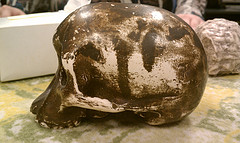Type Specimen for boisei is OH5.
This picture shows the comparison of the area under the nose, between OH5 and a human. Note the substantially large area under the nose to the upper teeth in OH5, compared to humans.
This picture shows the comparison of teeth (from left to right) in humans, OH5, and Lucy.
Top-view of OH5 (boisei). Note the flared zygomatic arches.
Side-view of OH5 (boisei). Note the sagittal crest towards the posterior of the neuro-cranium.
"Black Skull":
Top-view of "Black Skull." Note the presence of a sagittal crest and the present temporal lines and a strong post-orbital constriction.
The innominate of boisei. Note how there may be somewhat of an acetabulocristale buttress.
This picture shows the comparison in size of the mandible of a human (top) and a robust australopithecine.
KWM-ER-406:
Side-view of KWM-ER-406. Note the sagittal crest. Probably female, because more lightly built.
"Heart-shaped" foramen magnum. Characteristic of robust australopithecines.
Top-view of KWM-ER-406. Note the flared zygomatic arches, the large temporal fossa and the strong temporal lines, as well as a present sagittal crest.
3.13.2011
South African fun!
Males have more of a square jaw; females have a more pointed appearance (helpful in sexing remains).
"Taung Baby"
The age of Taung is about as developed as a 3 year-old.
This is about the same age as Taung and is the posterior region of the neurocranium. It has a rough area where the nuchal crest is.
Australopithecus africanus:
"Mrs. Ples" (STS5)
Top-view of Mrs. Ples. Shows the presence of post-orbital constriction.
The innominate of STS14 (top) and Lucy (bottom).
STW252: maxilla and teeth.
STW252. Note the projecting canine and that the M3 is still in the process of coming in.
STW53. Picture of the maxilla. Note how worn-down the teeth are.
This picture shows the variability of teeth and dental archade of africanus.
This picture compares the face of Mrs. Ples (STS5) and Kenyanthropus platyops. Mrs. Ples is "dish"-shaped, while platyops is flat.
"Taung Baby"
The age of Taung is about as developed as a 3 year-old.
This is about the same age as Taung and is the posterior region of the neurocranium. It has a rough area where the nuchal crest is.
Australopithecus africanus:
"Mrs. Ples" (STS5)
Top-view of Mrs. Ples. Shows the presence of post-orbital constriction.
The innominate of STS14 (top) and Lucy (bottom).
STW252: maxilla and teeth.
STW252. Note the projecting canine and that the M3 is still in the process of coming in.
STW53. Picture of the maxilla. Note how worn-down the teeth are.
This picture shows the variability of teeth and dental archade of africanus.
This picture compares the face of Mrs. Ples (STS5) and Kenyanthropus platyops. Mrs. Ples is "dish"-shaped, while platyops is flat.
"Lucy and friends"
Lucy, or Australopithecus afarensis, has more definition on the ridges of phalanges than humans; sort of an intermediate between chimps and humans.
This shows that ridges are present in an intermediate form on Lucy. Compare this to...
Chimps, who have present ridge definition on their phalanges.
This shows the hand of a human, Lucy, and a Chimp in comparison (Human on top)
This is the pelvis of Lucy. There is obvious wrapping of the illia, which would have allowed to get abductors to the side of the body.
In afarensis, there is sexual dimorphism. This picture shows sexual dimorphism in the femoral head.
Human pelvis and Lucy's pelvis side-to-side show that the two are about the same size (width-wise).
Here, the sciotic notch of Ardi (bottom) and Lucy (top) are about the same.
Cranium of Lucy
Note the ascending ramus on Lucy.
Lucy's dental archade is a modified-V shape.
Picture of a chimp. Note the projecting canine. Also, note the diastema and the honing facet on LP3.
This shows that ridges are present in an intermediate form on Lucy. Compare this to...
Chimps, who have present ridge definition on their phalanges.
This shows the hand of a human, Lucy, and a Chimp in comparison (Human on top)
This is the pelvis of Lucy. There is obvious wrapping of the illia, which would have allowed to get abductors to the side of the body.
In afarensis, there is sexual dimorphism. This picture shows sexual dimorphism in the femoral head.
Human pelvis and Lucy's pelvis side-to-side show that the two are about the same size (width-wise).
Here, the sciotic notch of Ardi (bottom) and Lucy (top) are about the same.
Cranium of Lucy
Note the ascending ramus on Lucy.
Lucy's dental archade is a modified-V shape.
Picture of a chimp. Note the projecting canine. Also, note the diastema and the honing facet on LP3.
It continues
Chimp hand on left, human hand on right. The wrist bones are in the weight-bearing direction in chimps.
Comparison of Chimp, Human, and Ardi hands (from top to bottom)
This shows that there is a same general size of the proximal tibia in both Ardi (what's being held) and Humans.
In chimps, a sulcus is present.
Whereas in Ardipithecus ramidus, a sulcus is not present. Post-orbital constriction is present.
In Kenyanthropus platyops, post-orbital constriction is present.
Comparison of Chimp, Human, and Ardi hands (from top to bottom)
This shows that there is a same general size of the proximal tibia in both Ardi (what's being held) and Humans.
In chimps, a sulcus is present.
Whereas in Ardipithecus ramidus, a sulcus is not present. Post-orbital constriction is present.
In Kenyanthropus platyops, post-orbital constriction is present.
Subscribe to:
Posts (Atom)







































